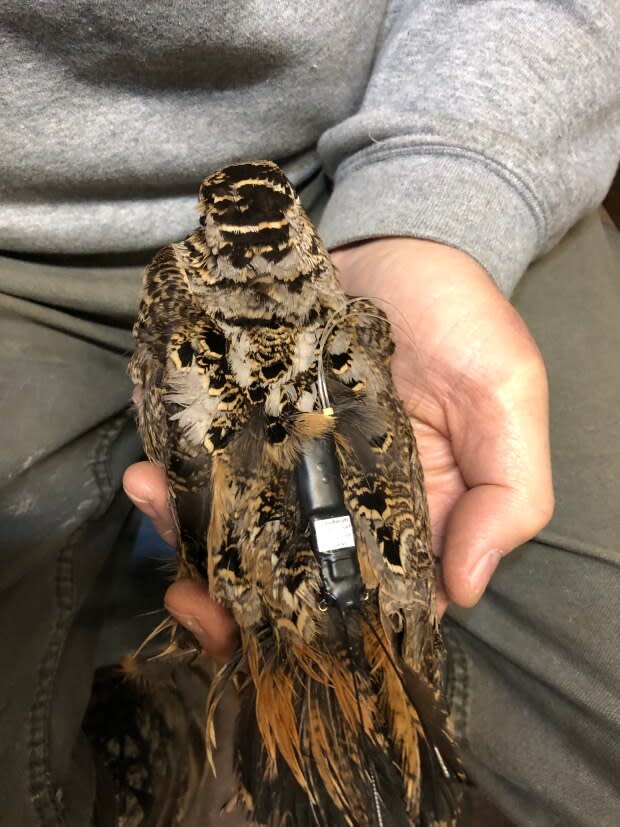Migration study shows chubby American woodcock is a remarkable athlete
Based on its appearance, you likely wouldn't think the American woodcock would turn out to be a phenomenal athlete.
Spending most of its life on the ground, hunting earthworms with its long beak, the chubby, bug-eyed bird looks more couch potato than marathon champ.
But an international study on the bird's migration patterns is showing researchers the woodcock is a remarkable flier.
The researchers have been placing GPS transmitters on woodcock captured all along the eastern seaboard, from the Carolinas to Nova Scotia.
And this spring, their movements during their annual migration north has shown some amazing achievements.
Erik Blomberg, an associate professor in the department of wildlife ecology at the University of Maine, is one of the leads on the project, which is in its third year.

"They're not necessarily built like they should be able to do really long, really athletic flights," Blomberg said.
In fact, Blomberg said, when they are not migrating, they don't move around much at all. It's not unusual to find a bird staying for long periods of time in areas no larger than an acre or so.
The researchers came to the Maritime provinces last summer to place transmitters on woodcock here. Part of the reason for doing that was to see how these birds deal with crossing open water.
Blomberg said that in the fall, two of the birds travelled from the Truro area to the tip of Nova Scotia, near Yarmouth, then headed out over the Gulf of Maine.
"From there, one bird made landfall in southern Massachusetts, one bird made it all the way to western Long Island, so that's a trip of about 250 miles over water, which is a pretty remarkable thing to see a small bird like a woodcock do."

The spring migration also brought a remarkable and surprising over-water migration north.
In December 2019, a woodcock was captured in Cape May, N.J., and fitted with a transmitter.
Alexander Fish, a PhD candidate at the University of Maine who is also working on the study, said the bird went on to spend the winter in North Carolina and in late February began to head north.
Fish said, as far as they can tell, after stops in Pennsylvania and coastal New York, the bird flew non-stop across the Gulf of Maine and up the Bay of Fundy, and eventually set down on Cape Breton Island.
After spending some time there, it headed out again across the North Atlantic, finally stopping on the Avalon Peninsula in Newfoundland on April 16, a flight of about 520 kilometres over open water.
Bomberg said it's exciting to have followed the path of a bird to the farthest eastern extent of the woodcock's breeding range.
Record setting trip
Then there's the female caught in south-central Alabama and had an extra-long migration, thanks to bad weather, to the western extremes of the breeding range.
She left Alabama in early March and headed northwest, making it all the way to Winnipeg by late March.
But a series of snowstorms in the area forced her south into Minnesota. She didn't get to her final nesting area until early May.
"That bird, if you sum up all of her steps for her migration path from the Alabama area to that breeding area in Manitoba," said Blomberg, "She travelled over 3,300 kilometres, which is the longest single migration track that we've recorded since the project started."
The average migration distance recorded by the study is about 1,400 kilometres, so she more than doubled that.

The study has also brought a surprise for the research team. This year, they've been able to get data about the altitudes of the migration flights, which may hold a clue to how they're able to accomplish these feats.
"Some of those altitudes have been surprisingly high," Blomberg said, "with the tags recording values as high as a thousand metres above the ground."
A good tailwind
Blomberg said it raises questions about how much the woodcock are relying on high altitude tailwinds to help during migration.
Take the example of a female bird flying south from Saguenay, Que.
She stopped in Michigan, close to the southern border with Indiana, and the next leg of her trip was the longest non-stop flight recorded — and it was accomplished in record time.
"The very next day it was in western Mississippi, with a distance of 797 kilometres," Blomberg said, "Almost 800 kilometres in one overnight period, and presumably, in order to do that, it had to have one heck of a tailwind to blow it that far, that fast."
Since the GPS transmitters don't typically last longer than one migration cycle, the researchers will be back in the field later this summer to fit transmitters on new birds.
Beause of COVID-19 restrictions at the border, Blomberg said, the researchers won't be travelling to Canada.
Instead, they've sent transmitters to their Canadian partners, so they can do the field work themselves.
That way, the researchers will be ready to plot new migration routes this fall.
You can see the results of the last migration cycle by heading to woodcockmigration.org.


